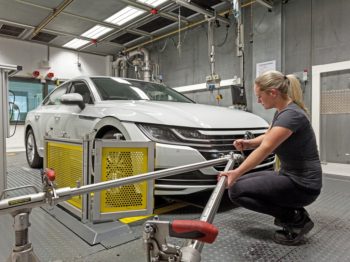Take a proactive approach to WLTP or face rising costs, fleets told
Fleets must take action on vehicle selection to mitigate the impact of WLTP or face escalating costs.

Manufacturers have been re-testing their entire model range under WLTP conditions since September 2017
So says FleetVision, the pan-European fleet and mobility consultancy arm within TÜV SÜD Group, as it highlights a number of measures that fleets across Europe should take now.
Effective from 1 September 2018 for all new cars, the new WLTP testing regime has been introduced to ensure more realistic fuel and CO2 figures for cars. Currently, figures are being converted back to NEDC equivalents – or ‘NEDC-Correlated’ figure – using a tool introduced by the European Union and known as CO2MPAS.
These figures are currently being used for emissions-based tax systems in many countries, including the UK’s company car tax and Vehicle Excise Duty, and are already bringing increased costs for fleets and drivers; latest figures from Jato show an average 9.6g/km uplift from the old ‘true’ NEDC figures to the new NEDC Correlated figures while the proper WLTP figures are likely to be higher still. According to FleetVision, many experts have identified at least a 25% increase in the CO2 emissions’ values between the NEDC-Correlated figure and WLTP; a discrepancy which will widely increase fleet and driver costs over time.
Although most EU member states are expected to make changes in their taxation systems in 2020 to mitigate the impact – including in the UK where an announcement was expected in this week’s Budget but failed to materialise – FleetVision says that waiting for the new systems is a mistake as fleets could see operating costs rise dramatically in the interim.
Instead, Thibault Alleyn, global consulting director at FleetVision, has urged fleets to take action now, highlighting several measures businesses could consider to ensure their policy lists were adjusted for the new WLTP figures.
“The first is to review the CO2 limit that has been set for the existing fleet policy and assess whether existing vehicles are capable of remaining within that limit under the new WLTP tests. This is especially valid for plug-in hybrid vehicles, which suffer the most,” he said.
“The second is to review the existing vehicle selection criteria and calculation formula, taking into account the WLTP values for each vehicle, and question whether this needs amending to ensure a future-proof selection method.
“Thirdly, fleet managers need to look at vehicle segments and engine sizes to assess which are the most affected in terms of higher emissions under the new WLTP rules. Some existing vehicles may automatically disqualify themselves from choice lists, which means having to evaluate the most suitable alternatives.”
Alleyn added that changes to CO2 values could mean powertrain policies need reviewing further.
“And fourthly, fleet managers need to look at equipment levels and options that are available to drivers on their choice lists, as some increase CO2 emissions under WLTP, which takes equipment into account. These include, amongst others, larger wheels, automatic gearboxes, sunroofs, air conditioning and tow bars,” he added.
Alleyn also warned that some models have now been axed, either permanently or temporarily, due to the shift to WLTP while there were longer delivery times on others.
His comments echo those of the UK’s Institute of Car Fleet Management (ICFM), which has said that the challenges posed by the introduction of WLTP “provide opportunities to fleet decision-makers to review existing company car choice lists and their whole modus operandi”.
ICFM chairman Paul Hollick continued: “It is imperative that, at the very least, fleet decision-makers keep company car drivers informed as to exactly what is happening with the introduction of WLTP, regularly review vehicle choice lists and keep firmly abreast of manufacturers’ data and new model introduction timetables.”

